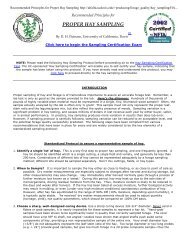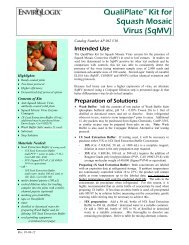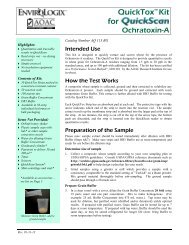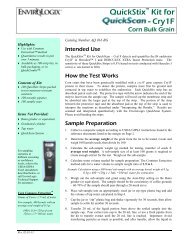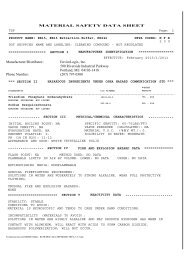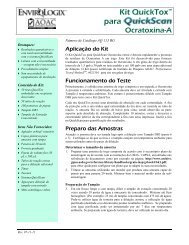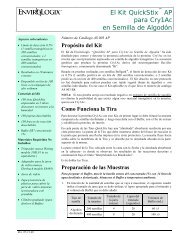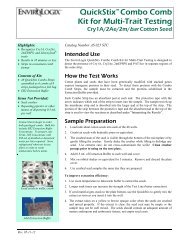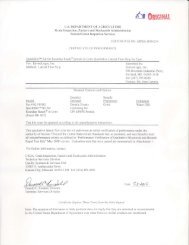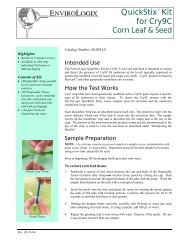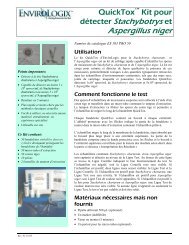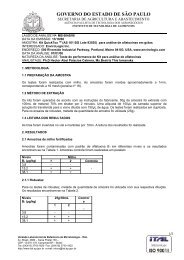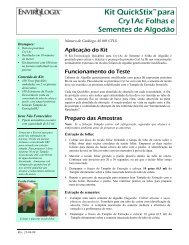Insert - EnviroLogix
Insert - EnviroLogix
Insert - EnviroLogix
You also want an ePaper? Increase the reach of your titles
YUMPU automatically turns print PDFs into web optimized ePapers that Google loves.
Highlights:<br />
• Results in 5 minutes or less<br />
• Available as 100-strip<br />
individual kits, or bulkpackaged<br />
strips<br />
• Also available in comb<br />
format for high-volume seed<br />
testing<br />
Contents of Kit:<br />
• 100 QuickStix Strips packed<br />
in two moisture-resistant<br />
canisters<br />
• EB2 Extraction Buffer<br />
• Dropper bottle<br />
• 100 Disposable Tissue<br />
Extractors (each consisting<br />
of a tube and pestle, with<br />
punch cap)<br />
Contact <strong>EnviroLogix</strong> to order<br />
bulk-packaged kits. Bulk kits<br />
include EB2 Extraction Buffer<br />
Concentrate. To prepare 1<br />
liter, mix 50 mL of 20X<br />
Concentrate with 950 mL of<br />
distilled or deionized water.<br />
Store refrigerated when not in<br />
use; allow to come to room<br />
temperature before using.<br />
Expiration date for prepared<br />
buffer is equal to that stated on<br />
the 20x container.<br />
Leaf tissue testing:<br />
Obtain leaf tissue, grind<br />
Rev. 03-26-10<br />
QuickStix Kit for Cry1F<br />
Leaf & Seed<br />
Catalog Number AS 016 LS<br />
Intended Use<br />
The <strong>EnviroLogix</strong> QuickStix Kit for Cry1F is designed to extract and detect the<br />
presence of the Bt endotoxin Cry1F found in Herculex I and Herculex XTRA<br />
(corn) and WIDESTRIKE® (cotton) Insect Protection traits. The QuickStix Kit will<br />
recognize the Cry1F protein in corn and cotton seed and leaf tissue extracts, with no<br />
cross-reactivity to any other commercially available GM proteins, including<br />
Cry34Ab1, Cry35Ab1 and PAT/pat. For Cry1F detection in bulk corn grain, please<br />
use QuickStix Cat. No. AS 016 BG.<br />
How the Test Works<br />
Corn and cotton crops that have been genetically modified with a cry1F gene express<br />
Cry1F protein in their tissue. To detect the protein, tissue samples must be extracted<br />
and the endotoxins solubilized in the Extraction Buffer provided.<br />
Each QuickStix strip has an absorbent pad at each end. The protective tape with<br />
arrows indicates the end of the strip to insert into the sample extract. The sample<br />
travels up the membrane strip and is absorbed into the larger pad at the top of the strip.<br />
The portion of the strip between the protective tape and the absorbent pad at the top of<br />
the strip is used to view the reactions as described under “Interpreting the Results.”<br />
Sample Preparation<br />
Note: If Extraction Buffer has been refrigerated, allow it to warm up to room<br />
temperature before preparing samples. Fill the dropper bottle provided with<br />
Extraction Buffer.<br />
Use extreme caution to prevent sample-to-sample cross-contamination with plant<br />
tissues, fluids, or disposables. Repeat the protocol for each sample to be tested using a<br />
new tube and toothpick. Avoid touching the pad at the bottom of the strip after<br />
handling leaf tissue.<br />
A. To extract corn leaf tissue:<br />
A1. Sandwich a section of folded leaf tissue between the cap and body of the<br />
Disposable Tissue Extractor tube. Snap two circular punches by closing the<br />
cap.<br />
A2. <strong>Insert</strong> a pestle into the tube and grind the tissue by rotating the pestle against<br />
the sides of the tube with twisting motions. Continue this process for 20 to<br />
30 seconds, or until the leaf tissue is well ground.<br />
A3. Holding the dropper bottle vertically, add 10 drops or pipette 0.5 mL of<br />
Extraction Buffer into the tube containing the leaf punch. Do not touch the<br />
dropper or pipette tip to the tube or leaf sample.<br />
A4. Repeat the grinding step to mix tissue with Extraction Buffer. Tap the solid<br />
materials to the bottom of the tube. Dispose of the pestle (do not re-use<br />
pestles on more than one sample).<br />
B. To extract cotton leaf tissue:<br />
B1. Sandwich a section of leaf tissue between the cap and body of the<br />
Disposable Tissue Extractor tube. Snap one circular punch by closing the<br />
cap.
Add buffer, grind again<br />
Seed tissue testing:<br />
Rev. 03-26-10<br />
Crush seed<br />
Extract seed sample<br />
<strong>Insert</strong> QuickStix Strip<br />
Any pink Test Line<br />
is considered positive<br />
QuickStix Kit for Cry1F Leaf & Seed<br />
Page 2 of 4<br />
B2. <strong>Insert</strong> a pestle into the tube and grind the tissue by rotating the pestle against<br />
the sides of the tube with twisting motions. Continue this process for 20 to<br />
30 seconds, or until the leaf tissue is well ground.<br />
B3. Holding the dropper bottle vertically, add 8 drops or pipette 0.35 mL of<br />
Extraction Buffer into the tube containing the leaf punch. Do not touch the<br />
dropper or pipette tip to the tube or leaf sample.<br />
B4. Repeat the grinding step to mix tissue with Extraction Buffer. Tap the solid<br />
materials to the bottom of the tube. Dispose of the pestle (do not re-use<br />
pestles on more than one sample).<br />
C. To extract corn or cotton seed tissue:<br />
C1. Crush a single seed (Suggestion: use pliers with seed in resealable plastic<br />
bag). Transfer to a tissue extraction tube marked with sample identification.<br />
C2. Holding the dropper bottle vertically, carefully dispense 20 drops or pipette<br />
1.0 mL of Extraction Buffer into the tube containing crushed corn kernel OR<br />
10 drops (0.5 mL) into the tube containing crushed cotton seed. Do not<br />
touch the dropper or pipette tip to the tube or seed sample.<br />
C3. Close the tube cap securely. Shake the tube vigorously for 20 to 30 seconds.<br />
After shaking step, tap the solid materials to the bottom of the tube.<br />
C4. Repeat the protocol for each sample to be tested, using a new tube and pestle<br />
for each. Use caution to prevent sample-to-sample cross-contamination with<br />
plant tissue, fluids, or disposables.<br />
How to Run the QuickStix Strip Test<br />
1. Allow refrigerated canisters to come to room temperature before opening. Remove<br />
the QuickStix Strips to be used. Avoid bending the strips. Reseal the canister<br />
immediately.<br />
2. Place the strip into the extraction tube. The sample will travel up the strip. Use a<br />
rack to support multiple tubes if needed.<br />
3. Allow the strip to develop in the extract for 5 minutes (if testing corn leaf/seed) or<br />
10 minutes (if testing cotton leaf or seed) before making final assay interpretations.<br />
Positive sample results may become obvious much more quickly. Allow the test to<br />
run for the full testing time before concluding a sample is negative.<br />
4. To retain the strip, cut off and discard the bottom section of the strip covered by<br />
the arrow tape.<br />
Interpreting the Results<br />
Development of the Control Line within the testing time<br />
indicates that the strip has functioned properly. Any<br />
strip that does not develop a Control Line should be<br />
discarded and the sample re-tested using another strip.<br />
If the sample extract contains Cry1F protein, a second<br />
line (Test Line) will develop on the membrane strip<br />
between the Control Line and the protective tape within<br />
5 (corn) or 10 (cotton) minutes of sample addition. The<br />
results should be interpreted as positive for Cry1F<br />
protein expression.<br />
If the extract is from a negative sample, the strip will<br />
only develop the Control Line.
Rev. 03-26-10<br />
Kit Storage<br />
QuickStix Kit for Cry1F Leaf & Seed<br />
Page 3 of 4<br />
This kit can be stored at room temperature, or refrigerated for a longer shelf life.<br />
Please note the shelf life on the kit box for each storage temperature. The kit may be<br />
used in field applications; however, prolonged exposure to high temperatures may<br />
adversely affect the test results (see “Precautions and Notes”). Do not open the<br />
desiccated canister until ready to use the test strips.<br />
Precautions and Notes<br />
• This kit is designed for screening for presence or absence only and is not meant to<br />
be quantitative.<br />
• As with all tests, it is recommended that results be confirmed by an alternate<br />
method when necessary.<br />
• The assay has been optimized to be used with the protocol provided in the kit.<br />
Deviation from this protocol may invalidate the results of the test.<br />
• Protect all components from hot or cold extremes of temperature when not in use.<br />
Prolonged exposure to high temperatures may adversely affect the test results. Do<br />
not leave in direct sunlight or in vehicle.<br />
• The results generated through the proper use of this kit reflect the condition of the<br />
working sample directly tested. Extrapolation as to the condition of the seed lot<br />
from which the leaf or seed sample was derived should be based on sound<br />
sampling procedures and statistical calculations which address random sampling<br />
effects, non-random seed lot sampling effects, and assay system uncertainty. A<br />
negative result obtained when properly testing the working sample does not<br />
necessarily mean the originating lot is entirely negative for the analyte or protein<br />
in question.<br />
• A negative result with this kit does not mean that the sampled tissue has not been<br />
otherwise genetically modified.<br />
• Age and condition of leaf tissue sampled can impact the intensity of the result.<br />
• A strong positive result may be safely interpreted in as little as 2 minutes after<br />
sample addition. It is not safe, however, to conclude that a sample is negative<br />
before the full testing time has elapsed.<br />
• Use extreme caution to prevent sample-to-sample cross-contamination with<br />
tissues, fluids, or disposables. Avoid touching the pad at the bottom of the strip<br />
after handling leaf tissue. Discard disposables after one use.
For Technical Support<br />
Contact Us At:<br />
<strong>EnviroLogix</strong><br />
500 Riverside Industrial<br />
Parkway<br />
Portland, ME 04103-1486<br />
USA<br />
Tel: (207) 797-0300<br />
Toll Free: 866-408-4597<br />
Fax: (207) 797-7533<br />
e-mail:<br />
info@envirologix.com<br />
website:<br />
www.envirologix.com<br />
Rev. 03-26-10<br />
LIMITED WARRANTY<br />
QuickStix Kit for Cry1F Leaf & Seed<br />
Page 4 of 4<br />
<strong>EnviroLogix</strong> Inc. (“<strong>EnviroLogix</strong>”) warrants the products sold hereunder (“the Products”) against<br />
defects in materials and workmanship when used in accordance with the applicable instructions<br />
for a period not to extend beyond a product’s printed expiration date. If the Products do not<br />
conform to this Limited Warranty and the customer notifies <strong>EnviroLogix</strong> in writing of such<br />
defects during the warranty period, including an offer by the customer to return the Products to<br />
<strong>EnviroLogix</strong> for evaluation, <strong>EnviroLogix</strong> will repair or replace, at its option, any product or part<br />
thereof that proves defective in materials or workmanship within the warranty period.<br />
ENVIROLOGIX MAKES NO OTHER WARRANTIES, EXPRESSED OR IMPLIED,<br />
INCLUDING BUT NOT LIMITED TO ANY IMPLIED WARRANTIES OF<br />
MERCHANTABILITY OR FITNESS FOR A PARTICULAR PURPOSE. The warranty<br />
provided herein and the data, specifications and descriptions of <strong>EnviroLogix</strong> products appearing<br />
in <strong>EnviroLogix</strong> published catalogues and product literature are <strong>EnviroLogix</strong>’ sole<br />
representations concerning the Products and warranty. No other statements or representations,<br />
written or oral, by <strong>EnviroLogix</strong>’ employees, agents or representatives, except written statements<br />
signed by a duly authorized officer of <strong>EnviroLogix</strong> Inc., are authorized; they should not be<br />
relied upon by the customer and are not a part of the contract of sale or of this warranty.<br />
<strong>EnviroLogix</strong> does not warrant against damages or defects arising in shipping or handling, or out<br />
of accident or improper or abnormal use of the Products; against defects in products or<br />
components not manufactured by <strong>EnviroLogix</strong>, or against damages resulting from such non-<br />
<strong>EnviroLogix</strong> made products or components. <strong>EnviroLogix</strong> passes on to customer the warranty it<br />
received (if any) from the maker thereof of such non-<strong>EnviroLogix</strong> made products or<br />
components. This warranty also does not apply to Products to which changes or modifications<br />
have been made or attempted by persons other than pursuant to written authorization by<br />
<strong>EnviroLogix</strong>.<br />
THIS WARRANTY IS EXCLUSIVE. The sole and exclusive obligation of <strong>EnviroLogix</strong> shall<br />
be to repair or replace the defective Products in the manner and for the period provided above.<br />
<strong>EnviroLogix</strong> shall not have any other obligation with respect to the Products or any part thereof,<br />
whether based on contract, tort, strict liability or otherwise. Under no circumstances, whether<br />
based on this Limited Warranty or otherwise, shall <strong>EnviroLogix</strong> be liable for incidental, special,<br />
or consequential damages.<br />
This Limited Warranty states the entire obligation of <strong>EnviroLogix</strong> with respect to the Products.<br />
If any part of this Limited Warranty is determined to be void or illegal, the remainder shall<br />
remain in full force and effect.<br />
License<br />
<strong>EnviroLogix</strong> has developed this kit using proprietary reagents as well as reagents<br />
licensed from Pioneer (DuPont Agriculture & Nutrition) Company and Dow<br />
AgroSciences.<br />
This test kit has been validated and approved by Dow AgroSciences for detection of<br />
their Herculex and WIDESTRIKE traits.<br />
Herculex and WIDESTRIKE are trademarks of Dow AgroSciences LLC<br />
<strong>EnviroLogix</strong>, the <strong>EnviroLogix</strong> logo, and QuickStix are trademarks of <strong>EnviroLogix</strong> Inc.<br />
© <strong>EnviroLogix</strong> 2010



